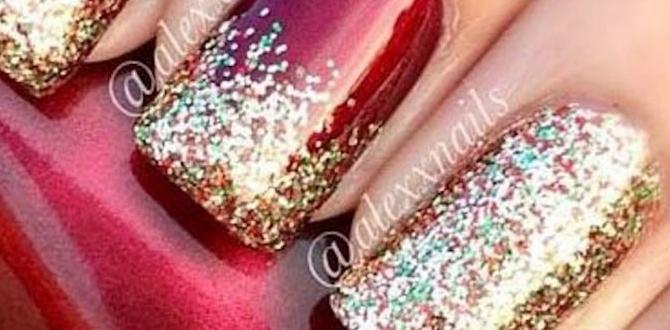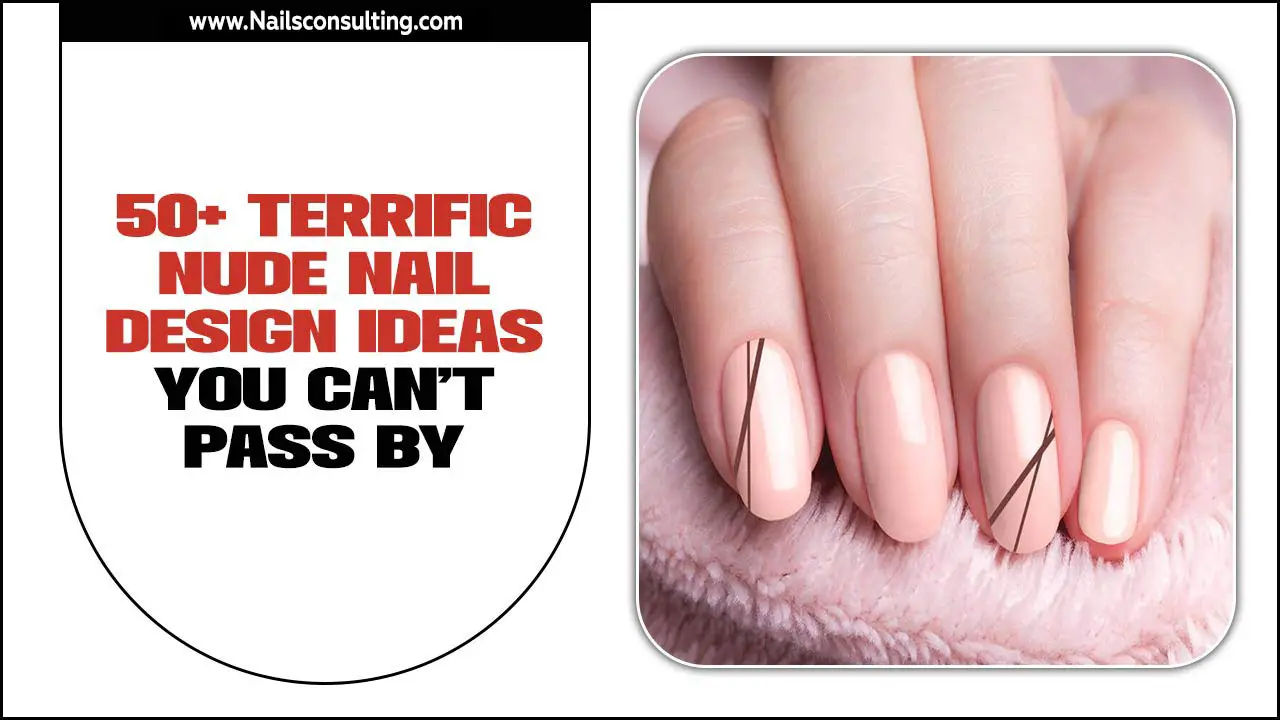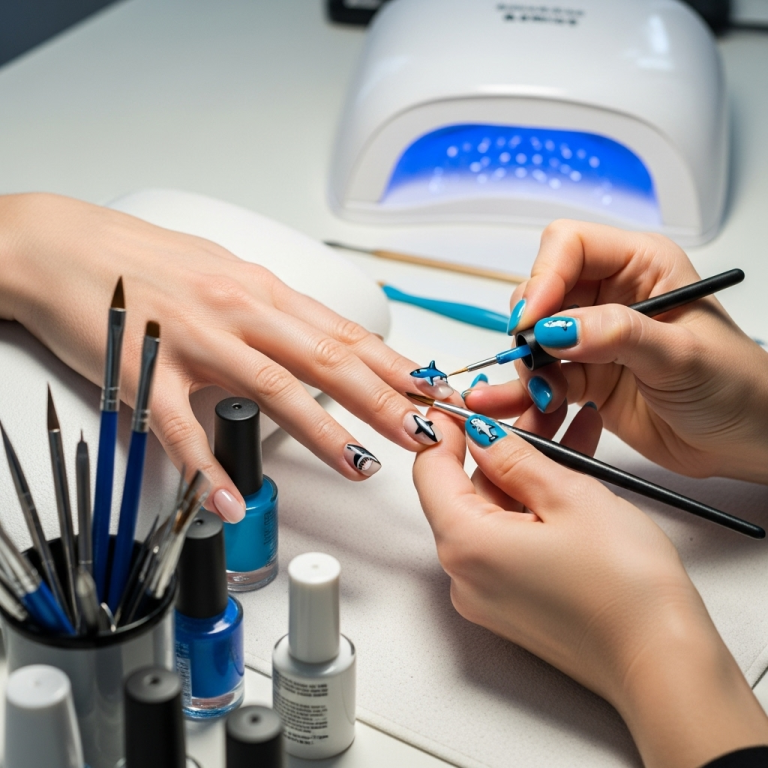Effortlessly achieve stunning marble nail designs at home with these simple, beginner-friendly tips! No professional tools or skills needed – just a few key supplies and our easy-to-follow guide will have you creating chic, unique manicures in no time.
Ever scrolled through nail art inspiration and marveled at those gorgeous, swirling marble designs? You know, the ones that look like tiny pieces of art on your fingertips? If you thought these elegant looks were only achievable at a salon, think again! Many of us feel intimidated by nail art, believing it requires a steady hand and years of practice. But the truth is, creating beautiful marble nails at home is totally doable, even for complete beginners. It’s all about understanding a few simple techniques and using the right methods. We’re here to break down the magic of marble nails, making it fun, easy, and totally achievable for you to recreate that salon-worthy look right at your own vanity.
Get ready to learn all the secrets, from the most basic water marbling to simpler, no-water methods that give you that luxurious marble vibe without any fuss. We’ll guide you through gathering your supplies and taking it step-by-step. You’ll be showing off your unique, handmade marble nails in no time, proving that gorgeous nail art isn’t just for the pros!
Your Marble Nail Design Toolkit: What You’ll Need
Before we dive into the fun part, let’s gather our battlefield supplies! Don’t worry, you won’t need a whole nail art studio. A few everyday items and some specialized polishes are all it takes. Having the right tools makes the whole process smoother and more enjoyable. Think of it as setting yourself up for success!
Here’s what you’ll find most helpful for creating beautiful marble nail designs at home:
- Base Coat: This is your nail’s best friend! A good base coat protects your natural nail from staining and helps your polish adhere better, ensuring a longer-lasting manicure.
- Your Chosen Polish Colors: For that classic marble look, you’ll typically want two to three colors that complement each other. White and black are a timeless duo, but feel free to experiment with blues, grays, pinks, or even metallics!
- Top Coat: Essential for sealing in your design, adding shine, and protecting against chips. A good quality top coat makes all the difference in how long your marble nails last.
- Nail Polish Remover: For those little oops moments, cleaning up edges, and removing excess polish from your skin. Cotton balls or pads work great.
- Orange Stick or Cuticle Pusher: Wonderful for cleaning up polish around your nail edges for a super neat finish.
- Optional: Lint-Free Wipes: If you’re going the water marble route, these are great for dabbing excess polish and for cleaning up.
- Optional: Liquid Latex or Barrier Cream: This is a lifesaver for water marbling! It creates a protective barrier around your cuticles, making cleanup a breeze.
- Small Cup or Bowl (for water marbling): You’ll need a container for your water.
- Toothpick or Needle: Crucial for swirling the polish in water marbling or for creating fine lines in other methods.
The Classic Marble: Water Marbling Method
This is the technique that truly captures the organic, swirled beauty of natural marble. While it might seem a little intimidating at first, with a little practice, you’ll get the hang of it. The key is patience and not overworking the polish!
Step-by-Step Water Marble Magic
- Prep Your Nails: Start with clean, dry nails. Apply a good base coat and let it dry completely.
- Protect Your Skin: This is where the magic (and mess prevention) happens! Apply a layer of liquid latex or a barrier cream around your cuticles and the skin surrounding your nails. This will peel off easily later, taking any stray polish with it.
- Prepare Your Water: Fill your small cup or bowl with room temperature water. Don’t use hot or cold water, as it can affect how the polish spreads.
- Start Dripping: Take your first polish color and gently drip a few drops onto the surface of the water. Don’t pour it; let it spread naturally.
- Layer Your Colors: Immediately after the first color, drip a few drops of your second color onto the center of the first drop. Continue alternating colors, creating concentric circles.
- Create the Swirls: This is the artistic part! Take your toothpick or needle and gently drag it from the center of the design outwards, then swirl it around to create patterns. You can make simple swirls, zig-zags, or more intricate designs. Don’t over-swirl, or the colors will become muddy. Aim for sharp lines and distinct color separation.
- Dip Your Finger: Once you have a swirl pattern you like, gently dip your prepared finger into the design. Angle your finger so the polish wraps around the nail surface. Gently press down and then slowly pull your finger straight up through the design.
- Clean Up: Carefully peel off the liquid latex or wipe away the barrier cream. Use a small brush dipped in nail polish remover to clean up any polish on your skin.
- Repeat and Seal: Repeat this process for all your nails. Once all your designs are done and the polish is mostly dry, apply a generous layer of top coat to seal the design and add shine. You can also use a clean toothpick to carefully remove any excess polish from around the cuticle area before the top coat.
A pro tip for water marbling: Experiment with different color combinations and swirling techniques to create unique patterns. For instance, try metallic polishes for an extra luxe effect. You can find great tutorials on color theory for nail art to help you pick shades that pop! For more detailed guidance on polish application, check out resources from reputable beauty authorities like Allure.
The Easier Marble: No-Water Techniques
Love the marble look but not the mess or the complex technique of water marbling? No worries! There are fantastic, beginner-friendly ways to achieve a marble effect without dipping your fingers into water. These methods are quicker, cleaner, and just as stylish.
Method 1: The Sponge Technique
This is probably the easiest and most popular method for DIY marble nails. It gives a beautiful, diffused marble effect that looks sophisticated and chic.
Step-by-Step Sponge Marble
- Prep: Apply your base coat and let it dry completely. Then, paint your nails with your base color (often white or a light nude). Let it dry thoroughly.
- Prepare Your Sponge: Grab a makeup sponge, a kitchen sponge (cut into small pieces), or even create a simple sponge applicator with a small piece of a makeup wedge. You want a slightly porous surface.
- Apply Polish to Sponge: On a clean, flat surface (like a plastic baggie or a non-porous palette), “paint” stripes of your chosen marble colors directly onto the sponge. You can use two or three colors. Don’t overload the sponge; a few quick dabs are enough.
- Dab Onto Nail: Gently and lightly dab the sponge onto your nail. You want to press just enough to transfer the polish. Don’t wipe or rub; just dab.
- Build the Design: You may need to reapply polish to the sponge and dab again to achieve your desired intensity and blend. For a more pronounced marble look, you can dab colors directly onto the nail and then gently dab over them with a clean part of the sponge to blend.
- Clean Up: Use your orange stick or cuticle pusher dipped in nail polish remover to clean up any polish that got onto your skin.
- Seal It: Once you’re happy with the marble effect, apply a generous layer of top coat to smooth out the texture and add shine.
Tip: Don’t press too hard with the sponge! A light touch will give you a more delicate, natural-looking marble. For a more intense marble, consider using darker, contrasting colors.
Method 2: The Swirl & Drag Technique
This method relies on a bit of polish manipulation on the nail itself, creating a more controlled, painterly marble effect. It’s less about random diffusion and more about intentional swirling.
Step-by-Step Swirl & Drag Marble
- Prep: Apply your base coat. Paint your nails with your lightest color (e.g., white or a pale shade) and let it dry completely.
- Apply Darker Colors: While the base color is still slightly tacky (or apply a quick-drying top coat and work on that while it’s wet), carefully drip or paint thin lines of your darker marble colors onto the nail. For example, if your base is white, add thin lines of black or gray.
- Swirl and Drag: Immediately take a toothpick or a fine nail art brush and gently drag it through the lines to create a swirling, marbled effect. You can drag in one direction, make a few swirls, or create a more abstract pattern. Be careful not to overwork it.
- Clean Up: Clean up any excess polish on your skin with your nail polish remover-dipped brush.
- Seal: Apply a thick, glossy top coat to seal in your design and give it that smooth, polished finish.
Pro Tip: For this technique, working quickly is key. Have all your colors and tools ready so you can create the effect while the polish is still wet and pliable. This method is great for achieving a more crisp, graphic marble look. For understanding polish viscosity and drying times, which are crucial for techniques like this, resources from material science sites can offer insights, like explanations on polymer drying at NIST. While not directly about nail polish, the principles of how materials dry and set are relevant.
Marble Techniques at a Glance
Understanding the differences between the methods can help you choose the best approach for your skill level and desired look. Here’s a quick breakdown:
| Method | Beginner Friendly? | Mess Factor | Time Commitment | Resulting Look |
|---|---|---|---|---|
| Water Marbling | Medium (requires practice) | High (without protection) | Medium to High | Organic, intricate, realistic marble |
| Sponge Technique | Very High | Low to Medium | Low to Medium | Diffused, blended, soft marble |
| Swirl & Drag Technique | High | Low | Low | Crisp, painterly, controlled marble |
Long-Lasting Marble Nails: Tips & Tricks
You’ve created a masterpiece! Now, how do you make sure those gorgeous marble nails stay looking fabulous for as long as possible? A little extra care goes a long way.
- Always Use a Top Coat: We mentioned it before, but it’s worth repeating! A good, thick top coat seals your design, adds shine, and most importantly, protects your manicure from chips and wear. Reapply every few days if needed.
- Use a Quick-Dry Top Coat if You’re in a Rush: These are amazing for instantly hardening your polish and reducing the risk of smudging right after application.
- Moisturize Your Cuticles: Dry cuticles can lead to peeling and cracking at the edges of your manicure, impacting its overall look. Keep your cuticle oil handy and use it daily.
- Wear Gloves for Chores: Harsh cleaning chemicals and prolonged water exposure are enemies of any manicure, including your beautiful marble nails. Slip on some rubber gloves before washing dishes or cleaning the house.
- Be Gentle: Avoid using your nails as tools! Try to open cans, scrape things, or pry objects with your fingertips instead.
- Touch-Ups are Okay: If you get a tiny chip, don’t despair! You can often carefully fill it in with a bit of top coat or even dab on a tiny bit of matching polish and re-seal.
For a deeper understanding of nail health and polish longevity, consulting resources on cosmetic science can be beneficial. For example, the U.S. Food and Drug Administration (FDA) provides information on cosmetic ingredients and safety, which can indirectly inform best practices for nail care and product use. You can explore their cosmetic information resources on the FDA website.
Troubleshooting Your Marble Designs
Even the most experienced nail artists have off days! If your marble design isn’t turning out quite right, don’t get discouraged. Here are some common issues and how to fix them:
- Polish is too thick/thin: If your polish is too thick, it won’t spread well. If it’s too thin, it might spread too much and get muddy. Try adding a drop of nail polish thinner to thicken stubborn polish, or if it’s too thin, try using fewer drops or letting it sit out for a few minutes to thicken slightly.
- Colors blending too much: This often happens with water marbling if you don’t work fast enough or if you over-swirl. For water marbling, try working with a pattern that’s already formed on the water’s surface, and dip your nail quickly. For other methods, try using less polish or dragging your tool just once or twice. Ensure your dried base layer is completely dry!
- Uneven texture after top coat: This is common with the sponge method because the layers can build up. Applying a generous, smooth top coat can help even it out. If it’s very bumpy, you might need a leveling base coat or a thicker, glossy top coat.
- Polish not sticking to the nail (water marbling): Ensure your nails are completely free of oils and lotions. A good base coat is crucial. Also, make sure the water temperature is correct – not too hot or too cold.
- Messy cleanup: Don’t skip the liquid latex or barrier cream for water marbling! For all methods, a small brush dipped in nail polish remover is your best friend for precision cleanup.
Frequently Asked Questions (FAQ)
Q1: Do I really need liquid latex for water marbling?
A1: While not strictly essential, liquid latex or a similar barrier cream (like Elmer’s glue or a cuticle cream) makes cleanup infinitely easier and less frustrating. It protects your skin from polish, so when you peel it off, any stray polish comes with it!
Q2: What’s the best kind of polish to use for marble nails?
A2: Standard nail polish works well. For water marbling, polishes that are formulated to spread well in water are ideal. Often, more opaque, creamy polishes perform better than sheer ones. You don’t need expensive brands; good quality drugstore polishes can work wonders!
Q3: Can I do marble nails on acrylic or gel nails?
A3: Absolutely! The techniques described can be applied to acrylic or gel nails. Just ensure your nail surface is properly prepped and that you’re working with dried polish or uncured gel according to your specific system. Always finish with your standard top coat (gel top coat for gel nails).
Q4: My water marble design looks muddy. What am I doing wrong?
A4: This usually happens when the polish layers mix too much. Try to be quicker when dripping and swirling your colors in the water. Don’t over-swirl with your toothpick! Sometimes using contrasting colors that don’t naturally create muddy tones (like black and white, or blue and white) can help.
Q5: How can I make the marbled design appear more defined?
A5: For the swirl & drag method, use thinner lines of color and drag your tool just once or twice. For water marbling, practice creating sharp swirls with your toothpick and dip your finger quickly to capture a less-blended pattern. A good, clean base coat and a strong top coat also help define the design.
Q6: I’m a complete beginner. Which marble technique should I try first?
A6: We highly recommend starting with the sponge technique! It’s the most forgiving, gives a beautiful result with minimal effort, and has the lowest mess factor. Once you’re comfortable with that, you can then experiment with the swirl & drag method, and eventually, if you’re feeling brave, the water marbling technique.
Embrace Your Inner Nail Artist!
And there you have it – your comprehensive



